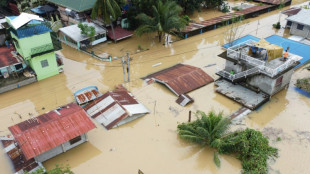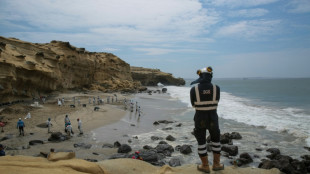
-
 Bird flu mutated inside US patient, raising concern
Bird flu mutated inside US patient, raising concern
-
Slovakia says ready to host Russia-Ukraine peace talks

-
 Maresca challenges Chelsea to react to Fulham blow
Maresca challenges Chelsea to react to Fulham blow
-
Tech slump slays Santa rally, weak yen lifts Japan stocks higher

-
 Test records for Zimbabwe and Williams as Afghanistan toil
Test records for Zimbabwe and Williams as Afghanistan toil
-
LawConnect wins punishing Sydney-Hobart yacht race

-
 Barca's Yamal vows to 'come back better' after ankle injury
Barca's Yamal vows to 'come back better' after ankle injury
-
Olmo closer to Barcelona exit after registration request rejected

-
 Watching the sun rise over a new Damascus
Watching the sun rise over a new Damascus
-
Malaysia man flogged in mosque for crime of gender mixing

-
 Montenegro to extradite crypto entrepreneur Do Kwon to US
Montenegro to extradite crypto entrepreneur Do Kwon to US
-
Brazil views labor violations at BYD site as human 'trafficking'

-
 No extra pressure for Slot as Premier League leaders Liverpool pull clear
No extra pressure for Slot as Premier League leaders Liverpool pull clear
-
Tourists return to post-Olympic Paris for holiday magic

-
 'Football harder than Prime Minister' comment was joke, says Postecoglou
'Football harder than Prime Minister' comment was joke, says Postecoglou
-
Driver who killed 35 in China car ramming sentenced to death

-
 Bosch gives South Africa 90-run lead against Pakistan
Bosch gives South Africa 90-run lead against Pakistan
-
French skier Sarrazin 'conscious' after training crash

-
 NATO to boost military presence in Baltic after cables 'sabotage'
NATO to boost military presence in Baltic after cables 'sabotage'
-
Howe hopes Newcastle have 'moved on' in last two seasons

-
 German president dissolves parliament, sets Feb 23 election date
German president dissolves parliament, sets Feb 23 election date
-
Slot says 'too early' for Liverpool title talk

-
 Mayotte faces environment, biodiversity crisis after cyclone
Mayotte faces environment, biodiversity crisis after cyclone
-
Amorm says 'survival' aim for Man Utd after Wolves loss

-
 Desertions spark panic, and pardons, in Ukraine's army
Desertions spark panic, and pardons, in Ukraine's army
-
China sanctions US firms over Taiwan military support

-
 World number six Rybakina makes winning start at United Cup
World number six Rybakina makes winning start at United Cup
-
Israeli strikes hit Yemen airport as WHO chief prepares to leave

-
 Swiatek not expecting WADA appeal over doping scandal
Swiatek not expecting WADA appeal over doping scandal
-
'Dangerous new era': climate change spurs disaster in 2024

-
 Fritz motivated for Slam success after low-key off-season
Fritz motivated for Slam success after low-key off-season
-
Move over Mercedes: Chinese cars grab Mexican market share

-
 Zverev aiming to challenge Sinner for top ranking
Zverev aiming to challenge Sinner for top ranking
-
N. Korean soldier captured in Russia-Ukraine war: Seoul

-
 Inspired Tsitsipas looking to 'refresh, regroup' in Australia
Inspired Tsitsipas looking to 'refresh, regroup' in Australia
-
Seahawks edge Bears to boost NFL playoff hopes

-
 Thunder NBA win streak at nine as Shai ties career high with 45
Thunder NBA win streak at nine as Shai ties career high with 45
-
India announces state funeral for ex-PM Manmohan Singh

-
 Japan govt approves record budget for ageing population, defence
Japan govt approves record budget for ageing population, defence
-
Japanese shares gain on weaker yen after Christmas break

-
 South Korea's acting president faces impeachment vote
South Korea's acting president faces impeachment vote
-
Fleeing Myanmar, Rohingya refugees recall horror of war

-
 Smith century puts Australia in control of 4th Test against India
Smith century puts Australia in control of 4th Test against India
-
Israeli strikes hit Yemen as Netanyahu fires warning

-
 Peru ex-official denies running Congress prostitution ring
Peru ex-official denies running Congress prostitution ring
-
Australia's Smith reaches 34th Test century

-
 NHL Red Wings fire Lalonde and name McLellan as head coach
NHL Red Wings fire Lalonde and name McLellan as head coach
-
The Bilingual Book Company Launches New, Innovative Bilingual Audiobook App

-
 Injured Halep withdraws from Australian Open
Injured Halep withdraws from Australian Open
-
Liverpool power seven points clear, Man Utd crash at Wolves

| RBGPF | -1.17% | 59.8 | $ | |
| CMSC | -0.34% | 23.58 | $ | |
| GSK | -0.69% | 33.885 | $ | |
| VOD | -0.06% | 8.415 | $ | |
| RIO | -0.7% | 58.84 | $ | |
| SCS | -0.46% | 11.845 | $ | |
| NGG | 0.34% | 59.12 | $ | |
| BTI | -0.43% | 36.275 | $ | |
| RELX | -0.92% | 45.44 | $ | |
| BCC | -2.26% | 120.21 | $ | |
| CMSD | -0.33% | 23.4 | $ | |
| AZN | -0.85% | 65.96 | $ | |
| RYCEF | -0.69% | 7.2 | $ | |
| JRI | -0.83% | 12.1 | $ | |
| BCE | -1.15% | 22.61 | $ | |
| BP | 0.16% | 28.895 | $ |

El Nino spells trouble for vulnerable Galapagos iguana
Unusually warm for this time of year, the waters of the Pacific signal hard times for the reptilian inhabitants of Ecuador's iconic Galapagos Islands.
The balmy temperature is the first symptom of a new cycle of the El Nino weather phenomenon that periodically pronounces a sentence of starvation on the archipelago's marine iguanas.
Experts fear this El Nino could be one of the most intense in decades.
On the white sands of Santa Cruz island, a species called Amblyrhynchus cristatus can live for as long as 60 years, uniquely adapted among extant iguanas for ocean diving around the islands synonymous with Charles Darwin's theory of evolution.
With its sharp claws and crest of back spines, the reptile resembles a prehistoric creature.
It may look tough, but it is highly susceptible to temperature fluctuations in the Pacific that affect its main food source -- algae -- for which it digs among rocks under water or in the shallows.
Marine iguana populations "undergo extreme fluctuations by cyclic, but unpredictably recurring, famine (El Nino) and feast (La Nina) events," according to the International Union for Conservation of Nature (IUCN), which lists the species as vulnerable.
Last month, the US National Oceanic and Atmospheric Administration (NOAA) announced "El Nino conditions are present and are expected to gradually strengthen" as the year progresses.
El Nino events are marked by warmer-than-average sea surface temperatures in the central and eastern Pacific near the equator, and occur every two to seven years and last about nine to 12 months.
"We should be getting cold water now, at the end of June, July, August, but we still have very warm water," Danny Rueda, director of the Galapagos National Park, told AFP.
He cited two previous particularly harsh El Nino events: One in 1982 and another in 1997 that bleached corals and wreaked havoc on the islands' animal life -- also tortoises, penguins, cormorants and sea lions.
And "according to the forecasts, this could be (an) El Nino matching those in magnitude," said Rueda.
- Cannot swim far -
According to World Meteorological Organization (WMO) secretary general Petteri Taalas, "the newly arrived El Nino will turn up the heat and bring with it more extreme weather" to Latin America and the Caribbean.
In a statement issued Tuesday to accompany a report on climate change effects in the region, he cautioned that "early warnings... will be vital to protect lives and livelihoods."
The WMO says climate change is likely increasing the impacts of El Nino events "in terms of more intense heat and heavier precipitation."
Galapagos species are able to survive cyclical changes in the local climate. But if variations occur too often or are too extreme, species can struggle to recover a balance between births and deaths.
El Nino-induced food shortages can mean starvation for marine iguanas -- whose body length has been recorded during previous events to shrink by as much as five centimeters (1.9 inches). Male iguanas can grow up to about 1.3 meters (4.2 feet) long, females about half that.
"Predictions that climate change may increase the severity and frequency of El Nino events... suggest that some (marine iguana) subpopulations could be removed entirely," says the IUCN.
According to Rueda, there are about 450,000 iguanas on the islands. Their numbers, say the IUCN, can drop by 90 percent after a strong El Nino event.
- 'No preventive measures' -
Marine iguanas can dive up to 12 meters deep and stay under water for an hour, but they "cannot swim long distances in the open sea to look for food" made scarce by algae die-offs, said Washington Tapia, director of the NGO Galapagos Conservancy.
Less algae also means less fish to feed birds, sea lions and other island species.
El Nino also brings heavier rains to the Pacific that inundate turtle nests on the beaches and wash away eggs.
"It being a natural phenomenon, we have no preventive measures" against El Nino's effects, said park director Rueda.
"All we can do is count the post-El Nino populations to calculate what the impact was."
Some 1,000 kilometers (about 621 miles) off the Ecuadoran coast, the archipelago is also home to about 33,000 people.
The islands, popular with tourists, are a World Heritage Site and home to flora and fauna found nowhere else in the world.
Darwin visited in 1835 and developed his theory of evolution based on his studies of Galapagos species, including iguanas.
T.Resende--PC



